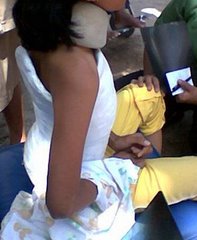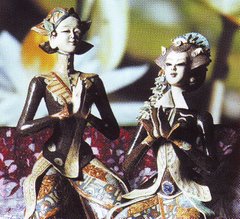

It is a story of my husband . He had a relapse of a gouty knee arthritis on October night, 10 th October 2007. A pain scale of 8 was noted on his left knee, and it made him aroused from his sleep at that night.
A laser therapy program was conducted using low energy diode laser for the pain.
At he following day he was able to drove to the mosque for Friday prayer and Iedl Fitri on 13 th October. Yet he took diclofenac simultaneously, but just for a single tablet.
The pain about 2 using scale for pain,

Here a copy from LIGHT SPEED
Gout & Laser Therapy
By Fred Kahn, MD, FRCS(C)
President Meditech International Inc.
Gout
Gout (also referred to as gouty arthritis) is a debilitating form of arthritis caused by the accumulation of uric acid crystals in the joints and tendons. It is an intensely painful disease that results from an increased uric acid concentration in the bloodstream. The most frequent location of symptoms is the 1st toe (75% of initial attacks), although it can also affect many other joints such as the ankle, knee, digits and spine.
Gout may be associated with renal disease, diabetes, obesity, leukemia and also the result of the use of diuretics.
Pathogenesis
Acute gout presents without warning. The exact cause of the disease is not known, although it is linked to a deficiency in purine metabolism. It can also be associated with minor trauma, overindulgence in purine-rich food, alcohol, surgery, fatigue, emotional and other stress. Purine is an organic compound that is common in the body and is metabolized into uric acid. Individuals suffering with gout usually have an increased concentration of uric acid in the blood, the result of increased production of uric acid and/or an impaired excretion thereof. This increased concentration of uric acid (hyperuricema) results in local deposits of monosodium urate (MSU) crystals in relatively avascular tissues (i.e. cartilage, tendons, ligaments, etc.) around the cooler distal peripheral joints (Figure 4). In severe long standing cases, this condition can also result in MSU crystals being deposited in larger central joints as well as also the kidneys (renal calculi). Uric acid is normally processed in the kidneys into a form of urate for excretion.
Stages
Gout can be subdivided into four distinct stages:
1. Asymptomatic
2. Acute
3. Intercritical
4. Chronic
In the first stage (asymptomatic), the uric acid levels in the blood increase, but there are no symptoms. The initial attack of gout marks the acute stage. These attacks generally resolve rapidly although severe attacks can last several days and can even extend several weeks.
Low Intensity Laser Therapy has been clinically demonstrated to shorten the duration of the initial outbreak in addition to relieving the pain associated with this stage. Following the initial attack, the patient enters a period of dormancy, known as the intercritical or symptom-free stage that may last for a long period of time. The majority of gout sufferers experience their second attack generally within 6 months to 2 years. In the chronic stage of the disease, attacks of gout become more frequent and polyarticular (affecting more than one joint). Large tophi (deposits of crystals) can be found deposited in many joints during this phase.
Signs and Symptoms
The onset of gout is generally confined to nocturnal pain in a single joint (monoarticular), although it can be associated with multiple joints. The pain becomes progressively more severe and at times can be excruciating. The symptoms often mimic those of acute infection with edema, elevated temperature and erythema. The soft tissues overlying the joint are usually extremely tender and in some instances even the presence of blankets touching the skin can be irritating. The overlying skin is tense, warm, shiny and red or purplish in colour. Fever, tachycardia, chills and malaise may also be present.
The secondary attacks usually affect only one joint and last only a few days, but subsequent attacks can affect several joints simultaneously or sequentially and persist for weeks if left untreated.
Diagnosis
Gout has such a distinct clinical signature that it can often be tentatively diagnosed by history and physical examination alone. Elevated serum urate (7mg/dL) supports the diagnosis but is not specific. This is due to the fact that 30% of the patients have a normal serum urate level at the time of their first attack. The definitive diagnosis of gout can be readily obtained from light microscopy of the joint fluid aspirated from the afflicted area. This will clearly demonstrate intracellular monosodium urate crystals.
Treatment
The first treatment administered should be directed to relieve pain. Conventionally this has consisted of the use of NSAID’s and analgesics to temporarily diminish pain sensation.
Low Intensity Laser Therapy (LILT) properly applied can significantly reduce the pain and swelling associated with acute outbreaks of gout immediately, with concomitant elimination of the requirement for pharmaceuticals. LILT acts rapidly to reduce the inflammation surrounding the joint capsule in addition to relieving the debilitating pain. At our clinics generally there is a total relief of pain following 1 to 3 treatments on sequential days. A recent publication on the use of laser therapy in treating the acute stage of gout demonstrated that “both laser therapy and diclofenac (NSAID) achieved rapid pain relief in patients with acute gouty arthritis, similar in efficacy. Laser therapy was more effective than diclofenac in patients with chronic pyrophosphate arthropathy and in patients with chronic apatite deposition disease”. The article supports that Low Intensity Laser Therapy should be selected as the treatment of choice in acute gout.
Following the reduction of these initial symptoms the conventional therapy is to administer colchicine which reduces the serum concentration of uric acid in the blood. As with most pharmaceuticals, colchicine produces undesirable side effects including GI tract symptoms. Avoiding purine rich foods such as meat, fish, dry beans, mushrooms, alcohol, in addition to consuming purine-neutralizing foods (i.e. fresh fruits and vegetables) could help reduce the concentration of uric acid. Even with a change in diet the success of this approach is limited in reducing the symptoms of gout. In addition to changes in diet, increasing the volume of liquids ingested, particularly water, aids in the body’s ability to excrete uric acid.
Recently Allopurinol has been developed as a long term treatment of gout. This treatment is useful in reducing the serum uric acid levels with concomitant reductions in the outbreaks of gout. Again there are obstacles with this approach as this treatment cannot be administered until after the attack has subsided. Other side effects include GI tract distress, hepatitis and a potentially harmful eczema. An additional negative aspect of this treatment is that it is a lifelong decision; ceasing treatment with Allopurinol causes an almost immediate relapse of gout due to the sudden rise in serum uric acid levels.
Recently, we had 2 complex cases of gout in rapid succession. Routinely, we treat 30-40 cases of gout per annum and in all cases we obtain rapid resolution of symptoms without early recurrence. The majority of patients on initial presentation have been on medications including Indomethacin, Colchicine, Allopurinol, etc. Most patients had continued to have persistent pain and presented in order to obtain more effective alternative therapy. Rapid resolution of pain and inflammation are infallible indicators of change in the affected joints. These two patients noted nearly 100% reduction in pain following their first treatment. Whereas this approach is highly effective, patients should also be cautioned to alter their dietary habits in order to maintain low uric acid levels. Our experience at Meditech indicates that LILT instituted at the onset of pain is the treatment of choice in both acute and chronic gout.








